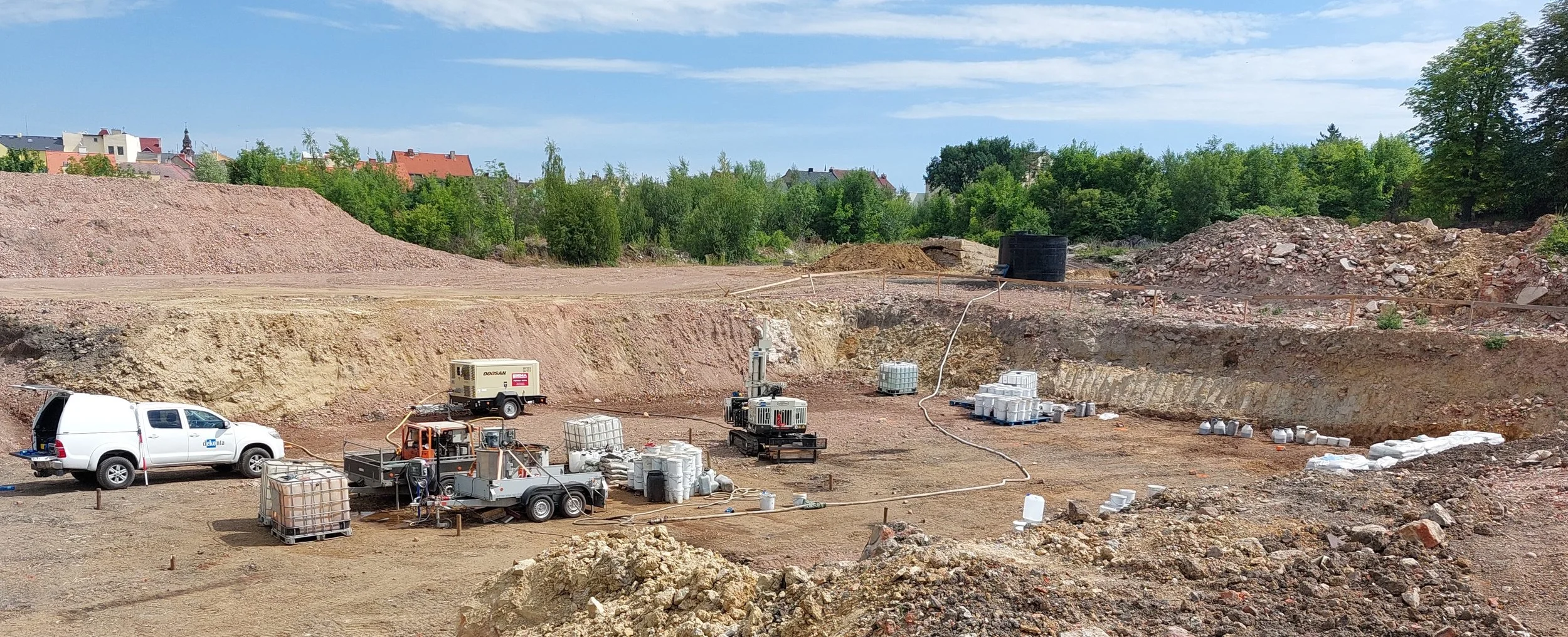The Method
Principle
Frac-In technology combines Direct-Push drilling with pneumatic and hydraulic fracturing to inject remediation agents in low-permeability contaminated soils. The injected suspension consists of a mixture of water, sand and thickening agent, containing tailor-made remediation agents such as coarse iron materials or other chemical reductants, and carbon sources to enhance bacterial activity.
Description
Traditional Direct Injection is performed by inserting a hollow rod into the soil using a Direct-Push drilling unit. The end of the rod is equipped with injection nozzles, which are closed while inserting the rod to prevent clogging. When the injection depth is reached, the injection nozzles are opened and a predetermined volume of a fluid is injected into the surrounding soil. When finished, the injection nozzles are closed again, and the rod is pushed into deeper horizons. In this way, a number of injections at different depths may be carried out in one push.
During the Frac-In process, it is also possible to carry out fracturing of low-permeability soils, which are generally considered inaccessible by standard injection techniques. The fracturing creates permeable pathways for the active agents to reach the contamination in the soil. Fracturing is accomplished by a combination of pneumatic and hydraulic pressures, forming a network of cracks in which the suspension is injected. The sand in the suspension acts as a proppant, filling up and stabilizing the cracks. The remediation agents in the injected suspension come into close contact with the contaminated soil, and start treating the contamination.
Applications
The Frac-In technology is recommended for treating contaminated soil and groundwater in low-permeability environments, such as clays, sandy clays and loam, when target contaminants can be treated in-situ. The current Frac-In suspensions are compatible with in-situ treatments consisting of chemical reduction and/or enhanced anaerobic bacterial treatment. This treatment works well for chlorinated solvents or heavy metals, often encountered at production plants, brownfields and industrial zones. Further development regarding reagents for ISCO and enhanced aerobic biodegradation is ongoing. The radius of influence (ROI) of the injections typically ranges from 4 to 6 m.
Technical challenge
Standard delivery procedures for remediation agents are based on injections of remedial solutions or suspensions at pressures lower than fracturing pressure. This enables the remedial agents to permeate in to existing pore space and migrate within these pores – usually upwards from the injection point. Using the Frac-In technology a mixture of innovative remediation suspensions designed for these purposes will be injected at a high pressure, sufficient to induce fractures in the soil matrix. Remedial agents will fill the newly induced fractures. These remedial suspensions will contain materials capable to serve as proppants – solid materials that keep newly induced fractures open after the pressure drops. The main technical challenge of Frac-In technology can be seen in developing a compact DP setup capable of creating fractures in the soil. Designing of the suitable injection setup for hydraulic fracturing is one of the Go/No Go milestones foreseen within this project. This setup will consist mainly of a high pressure pump, a holding vessel and injection probes; all connected with adequate hoses.
Creation of the innovative remediation suspensions will also be challenging. This concerns mainly innovative remediation suspensions based on enhanced aerobic (bio)degradation for petroleum derived compounds, as we do not foresee big difficulties for creation of the ISCR-ERD based innovative remediation suspensions. The main obstacle for the creation of remedial suspensions enhancing the aerobic biodegradation, can be seen in the need of a thickening agent to keep the solids in suspension before the injection; as all the suitable thickening agents (according to literature) are carbon based materials (and thus could serve as source of carbon for bacteria). Addition of carbon source into the underground will lead to depletion of part of the oxygen generated from co-injected oxygen release compounds. Developed remedial suspensions enhancing the aerobic biodegradation will have to contain minimal amounts of available carbon so that the effect of oxygen addition (via oxygen release compound) will be much higher than the oxygen depletion. The need for thickening agent is also main reason why we do not aim on creation of the ISCO based innovative remediation suspension, as we foresee interactions between ISCO reagents and the thickening agent, which will make it infeasible. Although we will carry out a few test to validate this theory.


